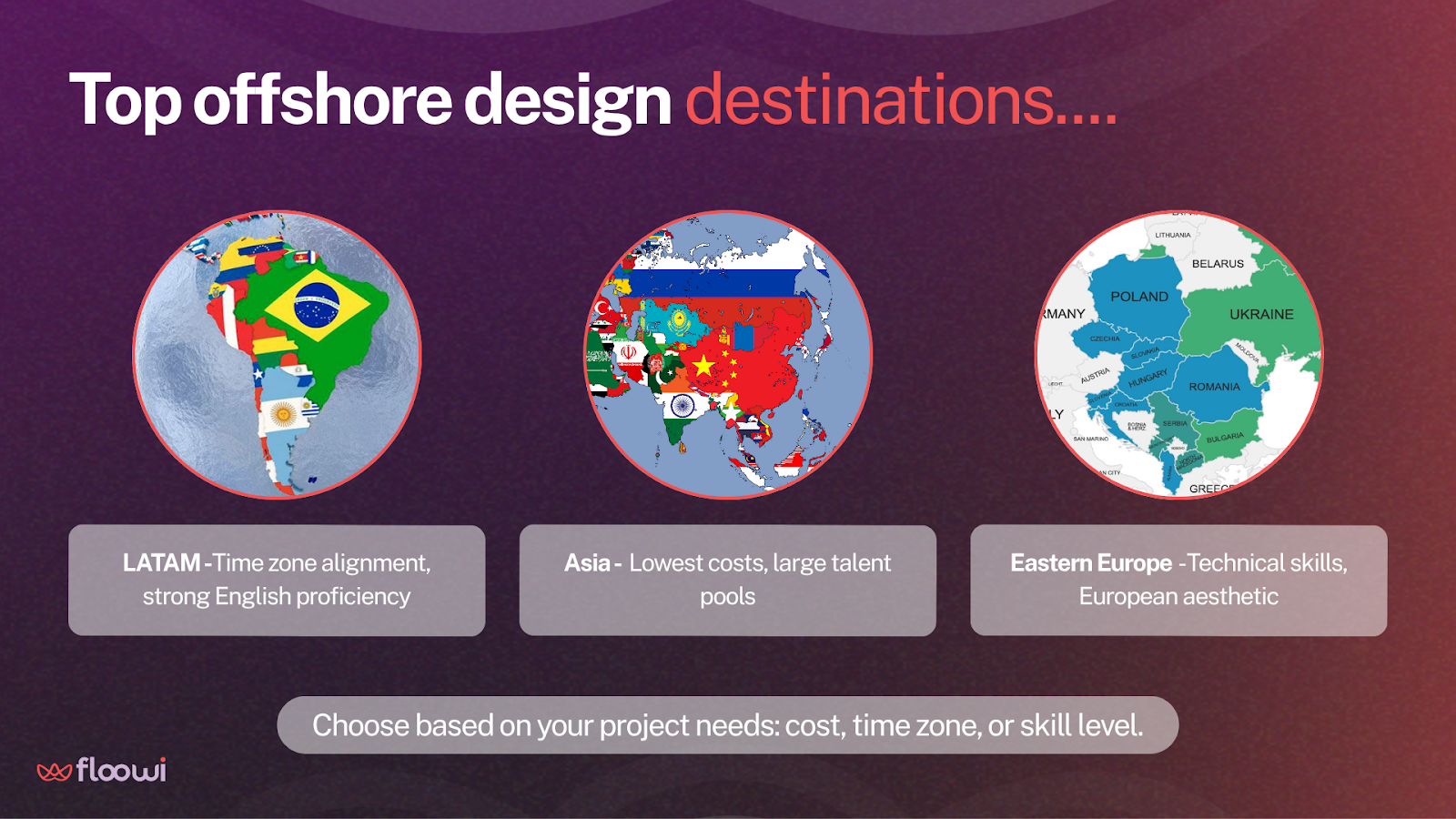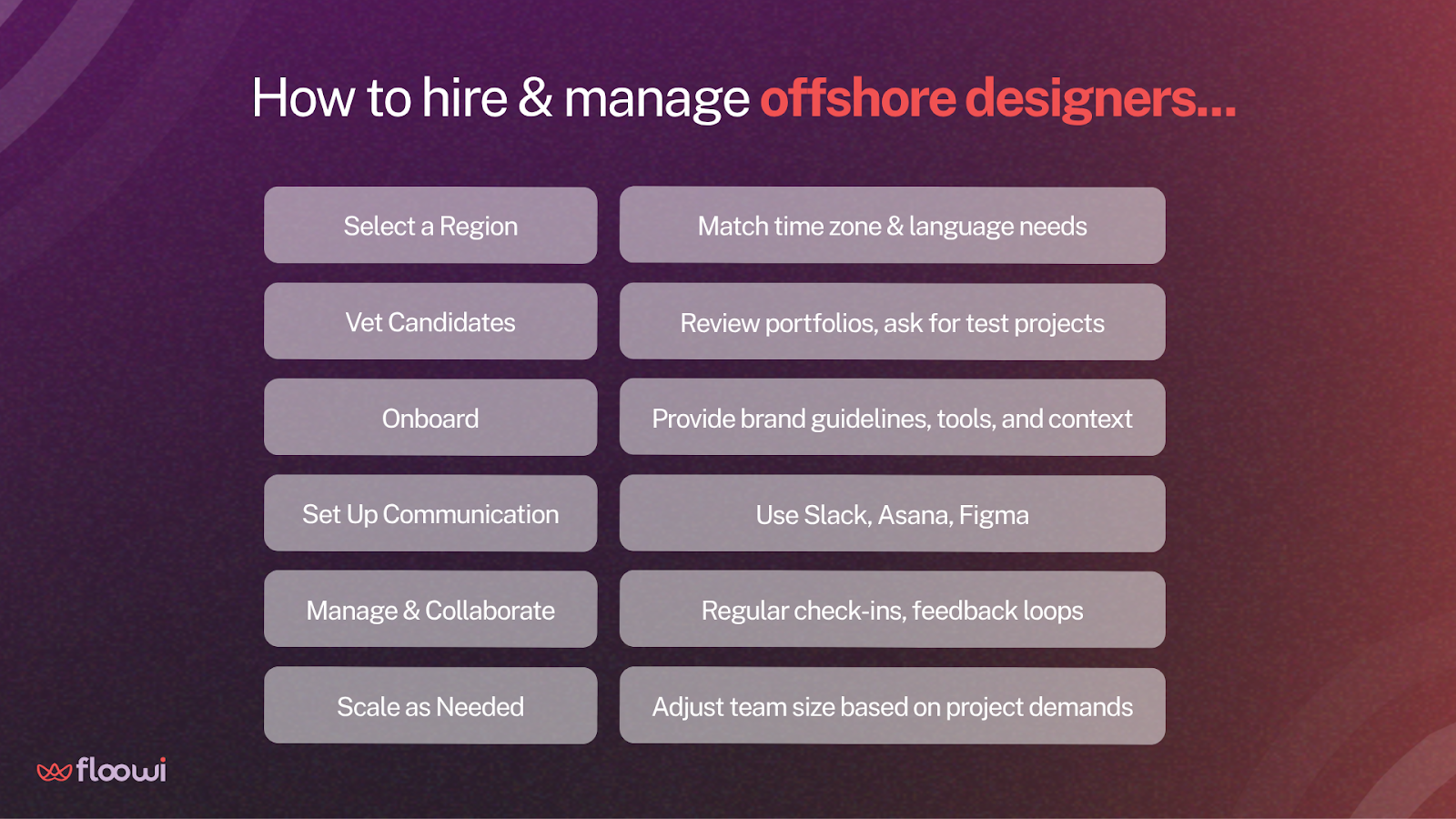Many companies want to build good design teams, but money is tight. Finding offshore designers has become a smart way to fix this problem. You gain access to top global designers who work flexibly and cost significantly less than local hires.
Businesses all over the United States are increasingly using offshore designers for everything from brand identity and web design to product UI/UX and marketing materials. The change is not solely about saving money. It's now about locating the right talent sooner and ramping up design capacity without the cost of hiring full-time locals.
Let’s see how offshore designers can help you build a strong team that doesn't cost too much.
What Offshore Designers Do (and Why Companies Hire Them)
Offshore designers are creative workers who live in other countries and work remotely. They do UI/UX design, web design, brand identity, motion graphics, and product visualization for companies.
Businesses hire these designers because they have got special skills, cost less money, and give flexible design help without making the local team bigger
What Offshore Design Services Include
Offshore design work usually includes:
- UI/UX Design: They do user research, wireframing, and make interfaces for apps and websites that people use.
- Branding: Logos, brand guidelines, and visual identity systems for companies, products, or even personal brands.
- Web & Mobile Design: Responsive layouts, accessibility design, and performance optimization.
- Motion Graphics & Illustration: Marketing visuals and explainer videos for campaigns.
How Offshore Is Different Than Outsourced
Outsourcing means contracting any external party for design work, whether they're across the street or across the ocean. Offshoring specifically means hiring talent from another country.
When you hire a local agency to outsource, you stay close and understand the culture better. But you pay top prices. Offshore recruitment lets you tap into talent all over the world and pay way less. The hard part is dealing with time zones and maybe some communication problems that come up.
A dedicated offshore designer works like a real team member. They join meetings and work on projects just like your local staff does. Project-based outsourcing to freelancers or agencies works better when you just need something done once.
Why Hiring Offshore Designers Helps Your Business
In 2025, marketing budgets are staying flat or getting smaller. But demand for digital content keeps growing bigger and bigger. Offshore design helps companies handle both these pressures by cutting costs and keeping production speed high.
New findings from We Are Amnet show more than a third of companies save 40-60% when they use offshore models. With numbers like that, lots of teams now see offshore design as a smart way to scale creative output while they keep spending under control.
1. Access Global Creative Talent at a Fraction of the Cost
Offshoring opens access to skilled designers worldwide, often at 50-70% lower costs than local hiring. For example, according to Payscale (2025), the average graphic designer salary in New York is $64,661 USD per year, while in Colombia, it’s around COL$26,400,000 (approximately $6,700 USD).
Designers with good skills in places like Latin America or Asia deliver work that's just as good. They charge $20-$49 per hour compared to $50-$150 in the U.S., so you save big without losing quality in your creative work.
2. Get More Work Done With Time Zone Overlap
Unlike offshoring to places that are 12 hours away or more, many top offshore locations share working hours with North America. Latin America especially works great for this.
Designers in Colombia or Mexico can join your daily stand-ups easy, they respond to feedback right away, and make changes during the same business day you're working.
3. Easily Scale Your Design Team as You Grow
Offshore hiring lets businesses grow fast or shrink back without the problems of local hiring. You bring on new designers for specific campaigns or when you launch products, then scale back down when the project needs change.
Top Countries for Hiring Offshore Designers in 2025

Different regions have different strengths you should know about.
Latin America (LATAM)
LATAM is now a leading destination for offshore design because of its cultural alignment, language proficiency, and proximity to the North American time zone.
Many U.S. firms collaborate with vetted offshore designers in LATAM through Floowi to ensure quality and quick onboarding.
South & Southeast Asia
India, the Philippines, and Vietnam give you some of the lowest design rates in the world. Time zone differences of 10-14 hours create coordination problems sometimes.
But these countries work great for production stuff like making assets, icon design, and updating templates.
Eastern Europe
Ukraine, Poland, Romania, and Serbia have a strong base of designers skilled in interaction design, accessibility, and developer collaboration. Most have extensive experience serving U.S. and European clients, so they are well-positioned for complex or compliance work.
Time zone overlap with U.S. teams is only two or three hours, but European firms find these locations convenient for close teamwork.
New Markets to Watch in 2025
African countries like Kenya and Nigeria are growing. Central Asian nations like Kazakhstan, too. They're becoming new hubs for digital design talent.
Their creative industries keep getting better, and internet connections improve, which makes them solid options for offshore hiring.
Hiring Models for Offshore Design Teams
The right choice depends on how big your project is. For ongoing design work, dedicated teams usually give you the best mix of consistency and cost control.
How to Find and Vet Reliable Offshore Designers
Good designers show clear thinking in their work. Look at how they define problems, make choices, and work with others. Don't just look at how pretty their visuals are.
Evaluating Portfolios and Skills
Ask candidates to explain a recent project step by step. What problem were they solving? How did they work with developers or other team members? What compromises or decisions did they make to meet goals or deadlines? Strong designers give clear, practical answers and link their choices to the final results.
Balancing Communication, Cost & Experience
Lower rates don't always mean lower total costs, actually. Junior designers need more help and more time from you. Senior designers work by themselves and finish projects faster and better.
Good designers ask questions and give you updates regularly. This stops misunderstandings before they happen. Match the time zone overlap to what your project needs. Real-time work needs overlap. Tasks that are defined clearly can happen asynchronously.
Pick an experienced one based on how complex things are. Junior designers fit good for clear tasks that are simple. Senior designers work best when projects get complex and need smart thinking.
Ask for a Paid Test Project
Run a small test that you pay for to see how they actually work. Keep it realistic and close to real work. Pay them fairly for their time.
Look at the results and process both. See how they handle feedback, if they meet deadlines, and how they communicate through the whole thing. Test a few candidates so you don't make expensive mistakes later.
Review Contracts and Legal Protection
Always define intellectual property rights clearly. Payment terms too, and confidentiality clauses. This stops ownership fights and makes sure your design assets stay protected like they should.
How to Manage Offshore Design Teams the Right Way

If you want this to work well, you need to plan how your team will communicate and collaborate.
Fixing Time Zone & Language Problems for Good Collaboration
Time zone differences need planning from you. Find overlap hours for live work - Latin America gives about 4-6 hours usually, Asia gives 1-2 hours most times.
Record meetings so people who can't come still see what happened. Use written briefs and recorded feedback when the overlap time is limited. Keep language clear and simple so miscommunication doesn't happen.
Using Project Management Tools for Real-Time Collaboration
Use tools that make work visible and easy to track. Figma allows real-time design collaboration.
Project management tools like Asana or ClickUp keep deadlines clear and tasks organized, where everyone sees them. Slack or Teams work perfectly for quick updates during the day.
Cloud storage makes sure everyone always uses the newest files. Short video walkthroughs save more time than long written explanations usually.
Building Cultural Alignment and Long-Term Partnerships
Include offshore designers in meetings and updates where possible.
- Provide brand guidelines, systems, and context.
- Hold regular feedback sessions.
- Build long-term relationships to reduce oversight and improve quality.
Cost Comparison: Offshore vs. Local Designers
In the U.S., rates depend more on experience and reputation:
- Established designers with strong portfolios typically charge $100-$200 per hour.
- Less experienced designers often charge $50-$75 per hour.
Other factors that influence costs include:
- Project complexity: A simple logo can cost $300-$800, while a complete brand identity package may run $1,500-$5,000.
- Type of design: Web design generally ranges from $75-$200 per hour. Interior design may be billed per project or room, between $2,000 and $12,000 per room.
- Timeline: Short deadlines increase costs. A project normally taking six weeks at $3,000 could rise to $4,500 if finished in three weeks.
- Extra employment costs: For U.S. designers, companies pay health insurance, retirement money, paid time off, and other benefits, too. These extras add over 30% to what you spein nd total. Latin American designers often work as independent contractors who don't need these benefits, so they cost less overall.
What You Should Remember:
- LATAM designers charge $25-$49 per hour, significantly lower than U.S. rates.
- Rates depend on experience, complexity, and type of work.
- Local hires come with additional benefit costs.
- Time zone alignment improves efficiency.
- Clear scope and realistic timelines help control costs.
How AI Makes Offshore Design Projects Faster and Better
Offshore design teams use AI tools more and more to work faster and keep quality high. These tools help with specific tasks, so designers focus on the complex parts of their work.
For instance, AI can:
- Generate design variants for A/B testing.
- Convert wireframes into high-fidelity mockups.
- Extract design tokens to ensure consistent theming.
- Summarize user research or feedback logs.
Examples of AI Tools in Use:
- Figma AI plugins (e.g., Autoflow, Magician) for layout and prototyping.
- Midjourney/Adobe Firefly for concept exploration and mood boards.
- Runway ML for simple motion graphics and video editing.
- ChatGPT / Claude for writing interface copy, alt text, or documentation.
These tools are integrated selectively based on project needs rather than being universally adopted.
Getting Started
Hiring an offshore designer in 2025 should be more than saving on costs. You must ask yourself if they can fit in well with your team, learn your processes, and produce consistent output.
So begin by selecting a region that corresponds to your time zone and language requirements. Then, screen candidates based on problem-solving abilities and not necessarily a great portfolio.
Engage them in your process early so that they get a context and can work with little supervision.
Start building your offshore design team with Floowi, book your free consultation today.
Frequently Asked Questions
How Much Does Hiring an Offshore Designer Cost?
Costs change based on region, experience, and how complex your project is. In Latin America, rates go from $25 to $49 per hour, typically. In Asia, rates are $20 to $40 per hour. Eastern Europe ranges from $40 to $70 per hour. Local U.S. rates go over $50 per hour most times, with senior designers charging $100-$200 per hour.
Which Countries Are Best for Hiring Offshore Designers?
It depends on what you care about most. For time zone alignment and easy language, Latin America works strongly. For saving money and big projects, South and Southeast Asia work well. Eastern Europe offers strong technical skills and design smarts for complex projects.
What Does an Offshore Designer Do Exactly?
They handle tasks like UI/UX design, brand identity, web and mobile layouts, motion graphics, and product visuals. Basically, they deliver the same creative output as local teams, but they work remotely from far away.
Who Owns the Intellectual Property for Offshore Design Work?
Ownership depends on what the contract says. Typically, IP rights should be defined explicit so the hiring company keeps full ownership of design assets they paid for.
Do Offshore Designers Match the Quality of Local Design Teams?
Yes, when you vet them correctly. Quality depends on their experience, their portfolio, and how well they fit into your workflow. Proper onboarding and clear communication matter more than where they live.
How Do I Manage an Offshore Design Team Good?
Start by setting clear expectations, defining how you communicate, and using project management tools like Figma, Asana, or ClickUp. Align time zones for real-time work where you can, and keep regular check-ins going.
How Long Does Onboarding an Offshore Designer to My Brand Take?
It takes 1-3 weeks for onboarding. This depends on how complex your brand is and if the designer knows your processes already. Clear briefs and brand guidelines help make this period shorter.
Are There Hidden Costs When You Hire Offshore Designers?
Yes, there are. Beyond hourly rates, you have to factor in onboarding time, project management overhead, communication tools, and revisions that might come up. But these costs get offset by lower hourly rates compared to what local hires usually cost.


.png)








.png)
.png)
